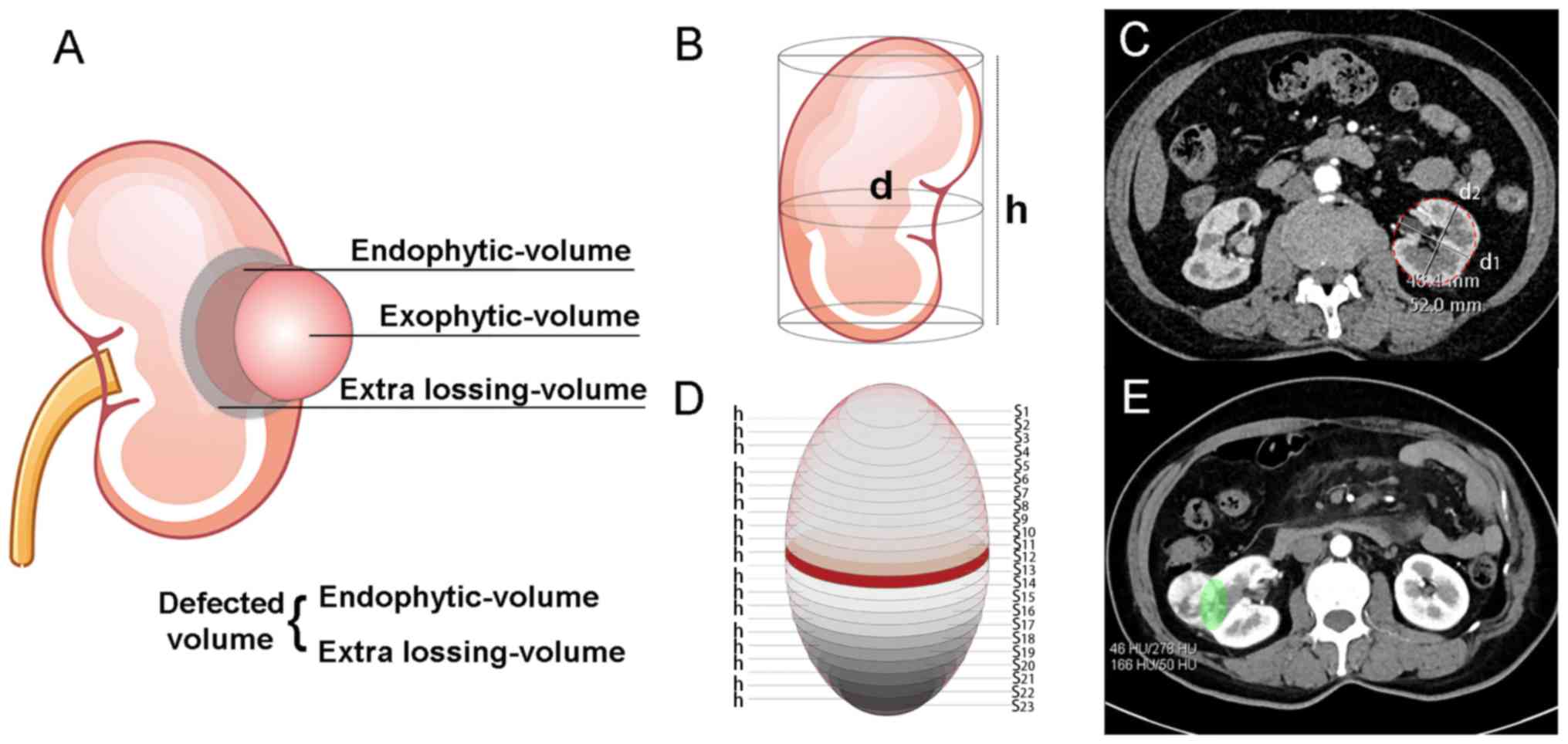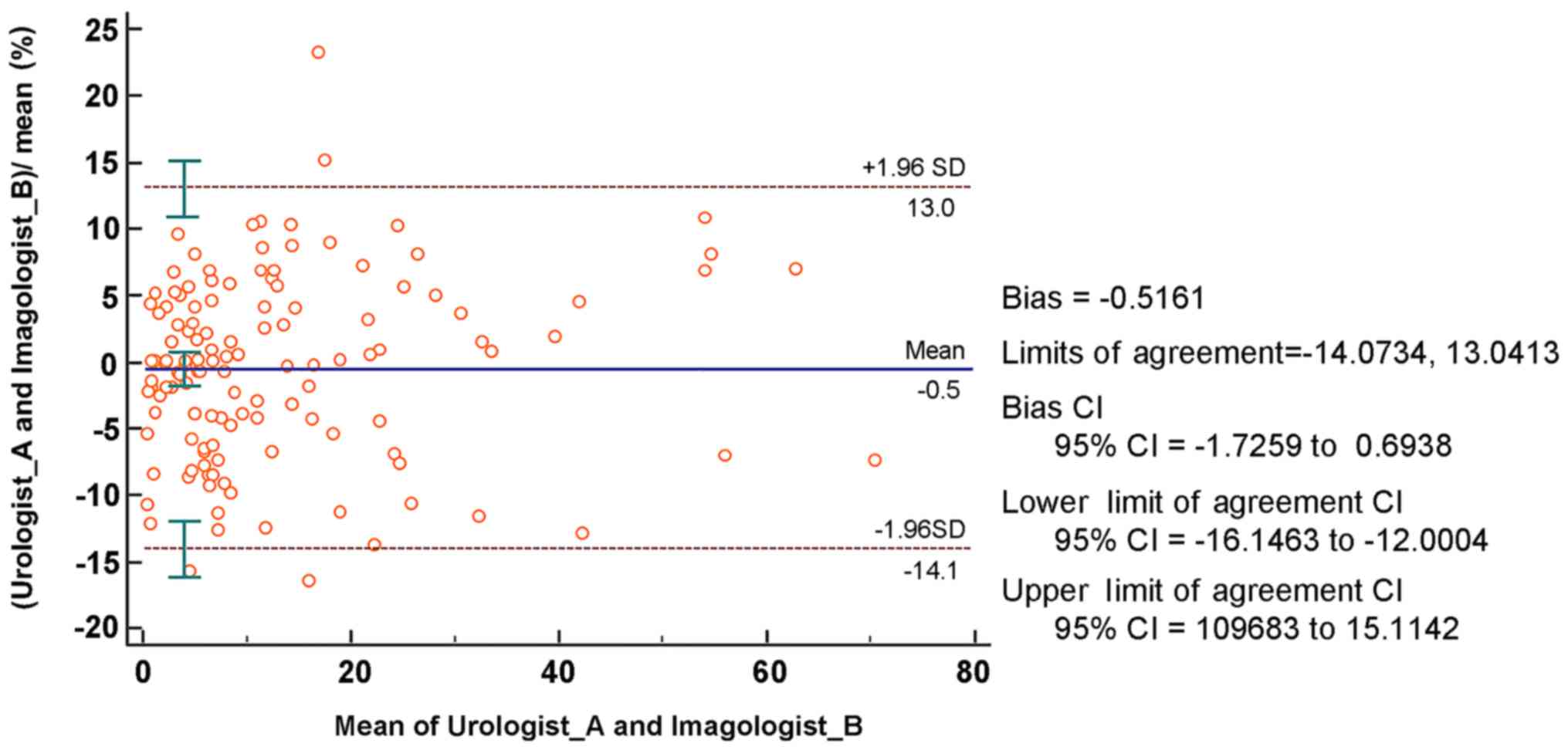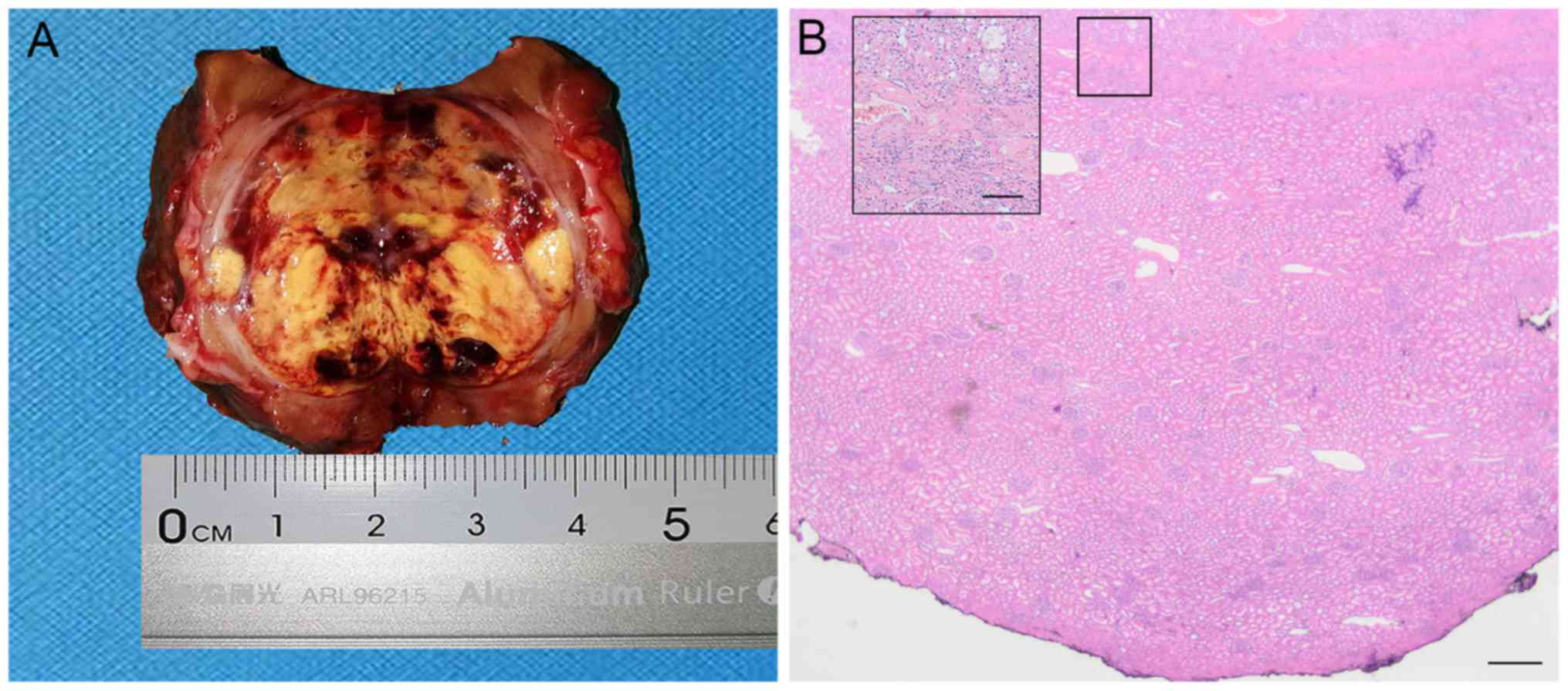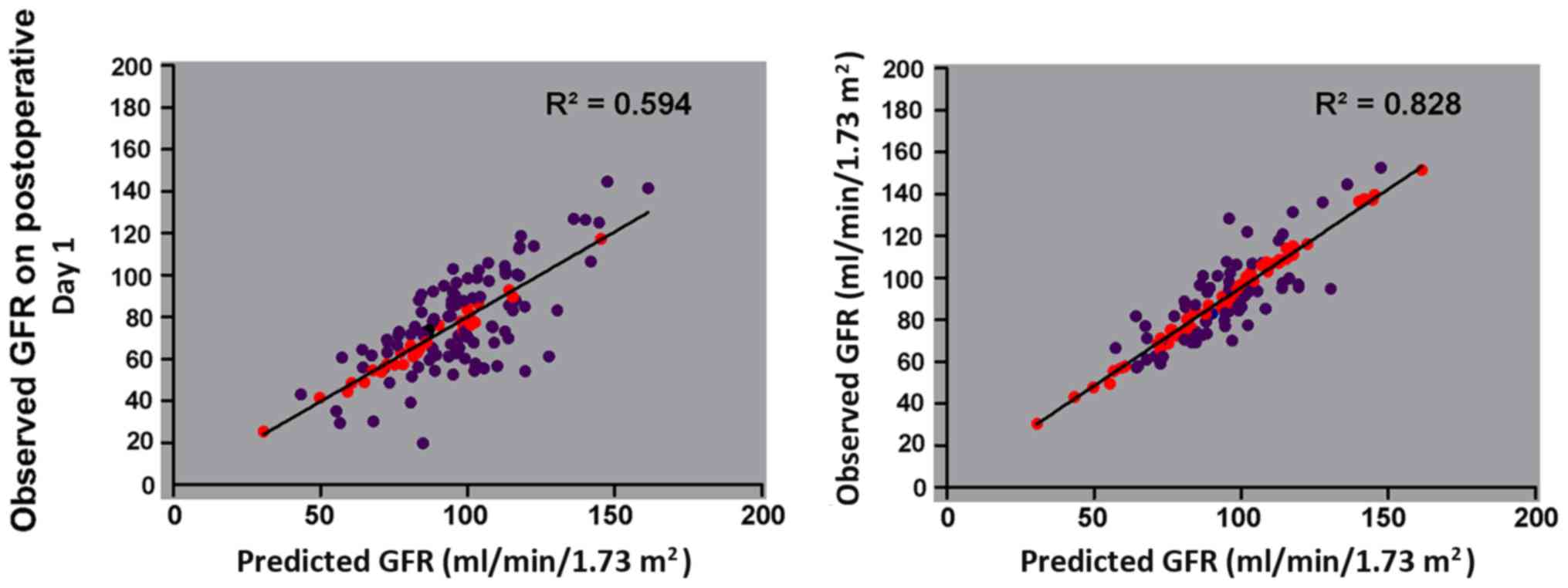|
1
|
Ljungberg B, Albiges L, Abu-Ghanem Y,
Bensalah K, Dabestani S, Fernández-Pello S, Giles RH, Hofmann F,
Hora M, Kuczyk MA, et al: European association of urology
guidelines on renal cell carcinoma: The 2019 update. Eur Urol.
75:799–810. 2019. View Article : Google Scholar : PubMed/NCBI
|
|
2
|
Mir MC, Derweesh I, Porpiglia F, Zargar H,
Mottrie A and Autorino R: Partial nephrectomy versus radical
nephrectomy for clinical T1b and T2 renal tumors: A systematic
review and meta-analysis of comparative studies. Eur Urol.
71:606–617. 2017. View Article : Google Scholar : PubMed/NCBI
|
|
3
|
Chawla LS, Eggers PW, Star RA and Kimmel
PL: Acute kidney injury and chronic kidney disease as
interconnected syndromes. N Engl J Med. 371:58–66. 2014. View Article : Google Scholar : PubMed/NCBI
|
|
4
|
Bernstein A, Barry E, Fram EB, Sankin A,
Kovac E and Stern JM: Does glomerular filtration rate at discharge
after partial nephrectomy predict long-term glomerular filtration
rate stability? J Endourol. 33:488–491. 2019. View Article : Google Scholar : PubMed/NCBI
|
|
5
|
Klatte T, Ficarra V, Gratzke C, Kaouk J,
Kutikov A, Macchi V, Mottrie A, Porpiglia F, Porter J, Rogers CG,
et al: A literature review of renal surgical anatomy and surgical
strategies for partial nephrectomy. Eur Urol. 68:980–992. 2015.
View Article : Google Scholar : PubMed/NCBI
|
|
6
|
Thompson RH, Lane BR, Lohse CM, Leibovich
BC, Fergany A, Frank I, Gill IS, Blute ML and Campbell SC: Renal
function after partial nephrectomy: Effect of warm ischemia
relative to quantity and quality of preserved kidney. Urology.
79:356–360. 2012. View Article : Google Scholar : PubMed/NCBI
|
|
7
|
Simmons MN, Fergany AF and Campbell SC:
Effect of parenchymal volume preservation on kidney function after
partial nephrectomy. J Urol. 186:405–410. 2011. View Article : Google Scholar : PubMed/NCBI
|
|
8
|
Lane BR, Russo P, Uzzo RG, Hernandez AV,
Boorjian SA, Thompson RH, Fergany AF, Love TE and Campbell SC:
Comparison of cold and warm ischemia during partial nephrectomy in
660 solitary kidneys reveals predominant role of nonmodifiable
factors in determining ultimate renal function. J Urol.
185:421–427. 2011. View Article : Google Scholar : PubMed/NCBI
|
|
9
|
Mir MC, Campbell RA, Sharma N, Remer EM,
Simmons MN, Li J, Demirjian S, Kaouk J and Campbell SC: Parenchymal
volume preservation and ischemia during partial nephrectomy:
Functional and volumetric analysis. Urology. 82:263–268. 2013.
View Article : Google Scholar : PubMed/NCBI
|
|
10
|
Chan AA, Wood CG, Caicedo J, Munsell MF
and Matin SF: Predictors of unilateral renal function after open
and laparoscopic partial nephrectomy. Urology. 75:295–302. 2010.
View Article : Google Scholar : PubMed/NCBI
|
|
11
|
Song C, Bang JK, Park HK and Ahn H:
Factors influencing renal function reduction after partial
nephrectomy. J Urol. 181:48–54. 2009. View Article : Google Scholar : PubMed/NCBI
|
|
12
|
Tobert CM, Boelkins B, Culver S, Mammen L,
Kahnoski RJ and Lane BR: Surgeon assessment of renal preservation
with partial nephrectomy provides information comparable to
measurement of volume preservation with 3-dimensional image
analysis. J Urol. 191:1218–1224. 2014. View Article : Google Scholar : PubMed/NCBI
|
|
13
|
Zargar H, Akca O, Autorino R, Brandao LF,
Laydner H, Krishnan J, Samarasekera D, Stein RJ and Kaouk JH:
Ipsilateral renal function preservation after robot-assisted
partial nephrectomy (RAPN): An objective analysis using
mercapto-acetyltriglycine (MAG3) renal scan data and volumetric
assessment. BJU Int. 115:787–795. 2015. View Article : Google Scholar : PubMed/NCBI
|
|
14
|
Mottrie A, Borghesi M and Ficarra V: Is
traditional laparoscopy the real competitor of robot-assisted
partial nephrectomy? Eur Urol. 62:1034–1036, Discussion 1038–1039.
2012. View Article : Google Scholar : PubMed/NCBI
|
|
15
|
Porpiglia F, Volpe A, Billia M and Scarpa
RM: Laparoscopic versus open partial nephrectomy: Analysis of the
current literature. Eur Urol. 53:732–743. 2008. View Article : Google Scholar : PubMed/NCBI
|
|
16
|
Levey AS, Bosch JP, Lewis JB, Greene T,
Rogers N and Roth D: A more accurate method to estimate glomerular
filtration rate from serum creatinine: A new prediction equation.
Modification of diet in renal disease study group. Ann Intern Med.
130:461–470. 1999. View Article : Google Scholar : PubMed/NCBI
|
|
17
|
Ficarra V, Novara G, Secco S, Macchi V,
Porzionato A, De Caro R and Artibani W: Preoperative aspects and
dimensions used for an anatomical (PADUA) classification of renal
tumours in patients who are candidates for nephron-sparing surgery.
Eur Urol. 56:786–793. 2009. View Article : Google Scholar : PubMed/NCBI
|
|
18
|
Simmons MN, Hillyer SP, Lee BH, Fergany
AF, Kaouk J and Campbell SC: Functional recovery after partial
nephrectomy: Effects of volume loss and ischemic injury. J Urol.
187:1667–1673. 2012. View Article : Google Scholar : PubMed/NCBI
|
|
19
|
Zhang Z, Zhao J, Velet L, Ercole CE, Remer
EM, Mir CM, Li J, Takagi T, Demirjian S and Campbell SC: Functional
recovery from extended warm ischemia associated with partial
nephrectomy. Urology. 87:106–113. 2016. View Article : Google Scholar : PubMed/NCBI
|
|
20
|
Thompson RH, Frank I, Lohse CM, Saad IR,
Fergany A, Zincke H, Leibovich BC, Blute ML and Novick AC: The
impact of ischemia time during open nephron sparing surgery on
solitary kidneys: A multi-institutional study. J Urol. 177:471–476.
2007. View Article : Google Scholar : PubMed/NCBI
|
|
21
|
Mir MC, Ercole C, Takagi T, Zhang Z, Velet
L, Remer EM, Demirjian S and Campbell SC: Decline in renal function
after partial nephrectomy: Etiology and prevention. J Urol.
193:1889–1898. 2015. View Article : Google Scholar : PubMed/NCBI
|
|
22
|
Volpe A, Blute ML, Ficarra V, Gill IS,
Kutikov A, Porpiglia F, Rogers C, Touijer KA, Van Poppel H and
Thompson RH: Renal ischemia and function after partial nephrectomy:
A collaborative review of the literature. Eur Urol. 68:61–74. 2015.
View Article : Google Scholar : PubMed/NCBI
|
|
23
|
Mir MC, Takagi T, Campbell RA, Sharma N,
Remer EM, Li J, Demirjian S, Stein R, Kaouk J and Campbell SC:
Poorly functioning kidneys recover from ischemia after partial
nephrectomy as well as strongly functioning kidneys. J Urol.
192:665–670. 2014. View Article : Google Scholar : PubMed/NCBI
|
|
24
|
Kopp RP, Mehrazin R, Palazzi K, Bazzi WM,
Patterson AL and Derweesh IH: Factors affecting renal function
after open partial nephrectomy-a comparison of clampless and
clamped warm ischemic technique. Urology. 80:865–870. 2012.
View Article : Google Scholar : PubMed/NCBI
|
|
25
|
Ginzburg S, Uzzo R, Walton J, Miller C,
Kurz D, Li T, Handorf E, Gor R, Corcoran A, Viterbo R, et al:
Residual parenchymal volume, not warm ischemia time, predicts
ultimate renal functional outcomes in patients undergoing partial
nephrectomy. Urology. 86:300–305. 2015. View Article : Google Scholar : PubMed/NCBI
|
|
26
|
Mitsui Y, Sadahira T, Araki M, Maruyama Y,
Nishimura S, Wada K, Kobayashi Y, Watanabe M, Watanabe T and Nasu
Y: The 3-D volumetric measurement including resected specimen for
predicting renal function after robot-assisted partial nephrectomy.
Urology. 125:104–110. 2019. View Article : Google Scholar : PubMed/NCBI
|
|
27
|
Tobert CM, Takagi T, Liss MA, Lee H,
Derweesh IH, Campbell SC and Lane B: Multicenter validation of
surgeon assessment of renal preservation in comparison to
measurement with 3D image analysis. Urology. 86:534–538. 2015.
View Article : Google Scholar : PubMed/NCBI
|
|
28
|
Liss MA, DeConde R, Caovan D, Hofler J,
Gabe M, Palazzi KL, Patel ND, Lee HJ, Ideker T, Van Poppel H, et
al: Parenchymal volumetric assessment as a predictive tool to
determine renal function benefit of nephron-sparing surgery
compared with radical nephrectomy. J Endourol. 30:114–121. 2016.
View Article : Google Scholar : PubMed/NCBI
|
|
29
|
Schwandt A, Denkinger M, Fasching P,
Pfeifer M, Wagner C, Weiland J, Zeyfang A and Holl RW: Comparison
of MDRD, CKD-EPI, and Cockcroft-Gault equation in relation to
measured glomerular filtration rate among a large cohort with
diabetes. J Diabetes Complications. 31:1376–1383. 2017. View Article : Google Scholar : PubMed/NCBI
|


















